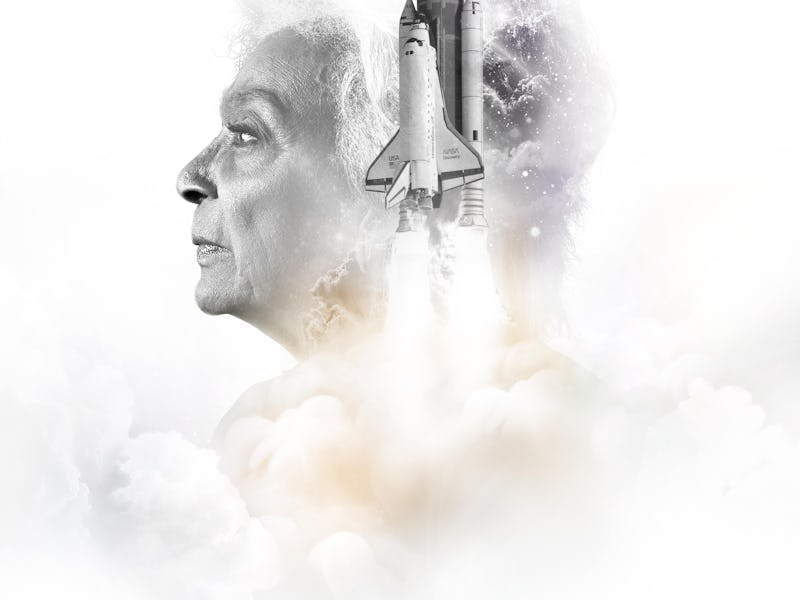New documentary reveals how Star Trek changed NASA forever
Woman in Motion highlights an overlooked and essential moment in spaceflight history.

Science fiction fans often think of 1977 as the year of Star Wars. But, more importantly, 1977 was when space exploration actually made strides toward Star Trek's vision of a diverse future. During a roughly four-month period in early 1977, Nichelle Nichols worked to recruit astronauts for NASA's then-new Space Shuttle program. Her goal was simple and self-fashioned: Get as many women and non-whites to apply as possible.
Nichols' 1994 memoir Beyond Uhura devotes less than one chapter to this astounding moment in history. Nichols' quest for diversity in space simply hasn't been talked about enough. That is, until now.
Previously on Apple TV, but now streaming on Paramount+, the documentary Woman In Motion chronicles Nichols' quest. Inverse caught up with director Todd Thompson, who insists NASA wouldn't look the same without Star Trek and Nichols.
"When Nichelle started her campaign NASA had very few Black or female applicants," Thompson tells Inverse. "I'm not saying zero. But Sally Ride and Ron McNair; yes, they were there as a direct result of her campaign with NASA. "
Nichelle Nichols as Uhura in the original Star Trek.
Nichols' involvement with the very first Star Trek conventions in the mid-1970s put her in contact with various NASA officials, including Dr. von Puttkamer. After attending one presentation about the future of space travel, she was struck with a problem:
"There was no one in the astronaut corps who looked anything like me. There were no women. No Blacks. No Asians. No Latinos."
Prior to working with NASA, Nichols started her own company, Woman In Motion Inc., to create new job opportunities for women. What she did next was to take the goals of that company and apply them to NASA. Unlike previous iterations of the space program — Mercury, Gemini, Apollo, et al. — the Space Shuttle program wasn't exclusively recruiting pilots and military officials. Like Star Trek's fictional Starfleet, a blend of civilians and specialists were needed to make the Space Shuttle fly.
Why didn't NASA have enough applicants? Nichols believed the problem was a matter of public trust. As the new documentary demonstrates, her belief was that people who might apply to be astronauts simply didn't believe that they would be taken seriously. She was also deeply concerned that if NASA didn't commit to the goal of diversity that what she was doing would be nothing more than a "media blitz."
As she says in the documentary, "If I put my name and my reputation on the line for NASA, and I find qualified women and minority people to apply, and a year from now I still see a lily-white, all-male astronaut corps, I will personally file a class action lawsuit against NASA."
Guion Stewart Bluford Jr., the first Black American in space.
Her determination worked. By 1983, Guion Stewart Bluford Jr. became the first Black American in space. In 1984, Ronald McNair became the second. Sally Ride became the first American woman in space in 1983.
Thompson doesn't think Ride, Bludord, or McNair were hardcore Star Trek fans, but also doesn't see how history could have played out any differently.
"The best way I can answer the question — 'could it have happened without her?' — is that those applicants reached out for a reason," he says. "If we'd already had the diverse Trek universe up there in space, there probably wouldn't have been a need for Nichelle to you know, go on a rampage and rally NASA."
The stranger question that Woman In Motion poses isn't so much about the historical fact of Nichols' efforts in driving diverse NASA recruitment, it's more of a larger question of why this story isn't more famous.
"I was amazed that only portion of a chapter in her memoir was dedicated to it," Thompson says. "I thought, how could that possibly be? It seems so monumental because we're making an entire film about it. Maybe for her, it was just that when you're in the thick of it, you just don't realize or recognize the importance. When the job's done, when the mission's complete, you kind of check the box and move on to the next thing."
Woman In Motion lingers on Nichols in the thick of it and shows how she did more for space travel working with NASA than she ever really did in the 1960s Star Trek. She used her power as a pop culture celebrity to bring people to space who might not have made it there otherwise. In one scene in the documentary, we also get to see Nichols flying the flight simulator for the Space Shuttle. It's an amazing moment because you realize that this famous science fiction icon, was, actually piloting a version of a Space Shuttle. In the simulation, at least, she was able to land the orbiter unassisted. She probably could have handled the real thing.
When asked in the documentary about successfully flying the Space Shuttle simulator, Nichols responds with a joke, saying, "It was Lt. Uhura."
Woman In Motion is streaming now on Paramount+.